CR14250SE Battery 3 V 1/2AA Lithium 850 mAh[Video]: Datasheet, Applications, and FAQ
BATTERY LITHIUM 3V CR14250
The CR14250SE is a 3V non-rechargeable Lithium Battery with 850mAh capacity. This article is going to talk about more detailed information about CR14250SE.

Pin Sanyo CR14250SE lithium 3v Made in Japan
Overview of CR14250SE
The CR14250SE is a 3V non-rechargeable Lithium Battery with 850mAh capacity. It has raised positive and flat negative terminals. 3V Lithium PLC Computer Backup Battery is widely used in numerical control systems, personal computers, and other electronics applications. This CR14250SE is a high-capacity cylindrical-type Primary Lithium Battery with a bobbin structure and laser-sealing. The CR2NP uses Lithium Manganese Dioxide chemistry for a high energy density and a wide operating temperature range of -40C to + 85C. Self-discharge is low at less than 0.5% per annum at 20C, giving an effective shelf life of 10 years.
Specifications
- TypeParameter
- Factory Lead Time16 Weeks
- Weight9g
- Operating Temperature (Max.)85°C
- Operating Temperature (Min.)-40°C
- Voltage Rated
RATED voltage is the voltage on the nameplate - the "design point" for maximum power throughput and safe thermal operation.
3V - Size / Dimension
In electronic components, the parameter "Size / Dimension" refers to the physical dimensions of the component, such as its length, width, and height. These dimensions are crucial for determining how the component will fit into a circuit or system, as well as for ensuring compatibility with other components and the overall design requirements. The size of a component can also impact its performance characteristics, thermal properties, and overall functionality within a given application. Engineers and designers must carefully consider the size and dimensions of electronic components to ensure proper integration and functionality within their designs.
0.57Dia x 0.98 H 14.5mmx25.0mm - Part Status
Parts can have many statuses as they progress through the configuration, analysis, review, and approval stages.
Active - Moisture Sensitivity Level (MSL)
Moisture Sensitivity Level (MSL) is a standardized rating that indicates the susceptibility of electronic components, particularly semiconductors, to moisture-induced damage during storage and the soldering process, defining the allowable exposure time to ambient conditions before they require special handling or baking to prevent failures
Not Applicable - Termination Style
"Termination style" in electronic components refers to the method used to connect the component to a circuit board or other electronic devices. It determines how the component's leads or terminals are designed for soldering or mounting onto the circuit board. Common termination styles include through-hole, surface mount, and wire lead terminations.Through-hole components have leads that are inserted through holes in the circuit board and soldered on the other side. Surface mount components have flat terminals that are soldered directly onto the surface of the circuit board. Wire lead terminations involve attaching wires to the component for connection.The choice of termination style depends on factors such as the type of component, the manufacturing process, and the space available on the circuit board. Different termination styles offer various advantages in terms of ease of assembly, reliability, and space efficiency in electronic designs.
Button Top (Extending) - Shelf Life
Shelf life in electronic components refers to the duration that a component can remain in storage under recommended conditions without significant degradation in its performance or reliability. It is an important factor for manufacturers and users, as prolonged storage may lead to changes in the material properties or functionality of the component. Typically, shelf life is specified for components such as capacitors, resistors, and semiconductors to ensure they perform as intended when implemented in electronic systems. Proper storage conditions, including temperature and humidity control, are crucial to preserving the shelf life of electronic components.
120 Months - Storage/Refrigeration Temperature
The parameter "Storage/Refrigeration Temperature" in electronic components refers to the recommended temperature range at which the components should be stored to maintain their integrity and functionality. This parameter indicates the temperature limits within which the components can be safely stored without risking damage or degradation. Storage temperature is crucial for preserving the performance and reliability of electronic components over time, especially for sensitive components such as integrated circuits and semiconductors. Refrigeration temperature may be specified for certain components that require lower temperatures to prevent degradation or prolong shelf life. It is important to adhere to the recommended storage/refrigeration temperature guidelines to ensure the longevity and proper functioning of electronic components.
Room Temperature - Terminal Type
Terminal type or emulation specifies how your computer and the host computer to which you are connected exchange information.
BUTTON(+), FLAT(-) - Shelf Life Start
Shelf Life Start refers to the point in time when the shelf life of an electronic component begins. The shelf life is the duration for which a component can be stored under specific conditions and still meet its performance specifications. The Shelf Life Start is typically marked by the date of manufacture or the date when the component is packaged and sealed. It is important to adhere to the specified shelf life guidelines to ensure the reliability and functionality of electronic components, especially in critical applications where performance is crucial.
Date of Manufacture - Battery Chemistry
A battery is a device that stores chemical energy, and converts it to electricity. This is known as electrochemistry and the system that underpins a battery is called an electrochemical cell. A battery can be made up of one or several (like in Volta's original pile) electrochemical cells.
Lithium Manganese Dioxide - Battery Cell Size
The most common lithium-ion cell is the 18650 (the numbers define the physical dimensions and shape as follows: 18mm in diameter, 65mm long and the 0 means it has a round cross-section) which is due to its widespread use in laptop battery packs.
CR14250 - Capacity
In electronic components, "Capacity" typically refers to the maximum amount of electrical charge that a component can store. It is measured in units called farads (F). Capacitors are the most common components that have a capacity rating. The capacity of a capacitor determines how much energy it can store and release when connected in a circuit. Higher capacity capacitors can store more charge and are often used in applications requiring larger energy storage or filtering capabilities. It is important to select a capacitor with the appropriate capacity to ensure proper functioning of the circuit.
850mAh - Discharge Rate
The "Discharge Rate" in electronic components refers to the rate at which a component can release stored energy or power. This parameter is particularly important in devices that use batteries or capacitors, as it determines how quickly these components can discharge their stored energy. A high discharge rate means that the component can release energy quickly, while a low discharge rate indicates a slower release of energy. Understanding the discharge rate of electronic components is crucial for designing circuits and systems that require specific power delivery characteristics.
0.5mA - Battery Type
Battery type refers to the specific chemistry and design of a battery that determines its characteristics, performance, and applications. Common battery types include alkaline, lithium-ion, nickel-metal hydride, and lead-acid, each with unique properties such as voltage, capacity, energy density, and discharge rates. The choice of battery type affects factors such as longevity, rechargeability, and suitability for various electronic devices and systems. Understanding battery type is crucial for selecting the appropriate power source for specific electronic components and applications.
PRIMARY - Diameter
In electronic components, the parameter "Diameter" typically refers to the measurement of the width of a circular component, such as a resistor, capacitor, or inductor. It is a crucial dimension that helps determine the physical size and fit of the component within a circuit or on a circuit board. The diameter is usually measured in millimeters (mm) or inches (in) and is important for ensuring proper placement and soldering of the component during assembly. Understanding the diameter of electronic components is essential for selecting the right size for a specific application and ensuring compatibility with other components and the overall design of the circuit.
14.5mm - RoHS Status
RoHS means “Restriction of Certain Hazardous Substances” in the “Hazardous Substances Directive” in electrical and electronic equipment.
Non-RoHS Compliant
CR14250SE Dimensions
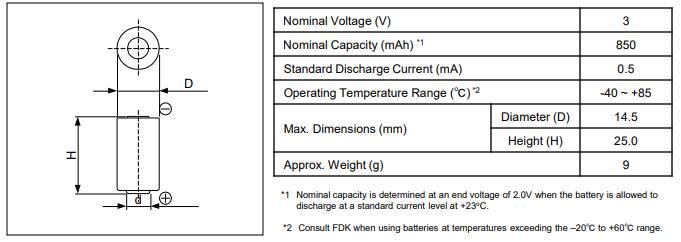
CR14250SE Dimensions
Related Articles about battery
CR14250SE Applications
water & electricity meters
fire alarm
memory backup power source
CR14250SE Manufacturer
By manufacturing and supplying electronic products and batteries that meet customers' needs, the FDK Group hopes to contribute to the achievement of an affluent electronics society. FDK provides products to enhance the value and functionality of our client's goods, in keeping with our customer-centric strategy. Our material, circuit, and high-density technologies have been developed through time and use environmentally benign materials. We want to be known around the world as one of the top suppliers of critical and cutting-edge gadgets, and we want to help advance these and other emerging technologies while also protecting the environment.
Datasheet PDF
- Datasheets :
Popularity by Region
What’s the operating temperature of CR14250SE?
-40°C~85°C TA.
What’s the capacity of CR14250SE?
850mAh.
What’s the discharge rate of CR14250SE?
0.5mA.
What is a CR14250SE?
The CR14250SE is a 3V non-rechargeable Lithium Battery with 850mAh capacity. It has raised positive and flat negative terminals. Manganese dioxide material. 0.5mA standard discharge current. -40 to 85°C operating temperature.
What’s the battery voltage of CR14250SE?
3V.
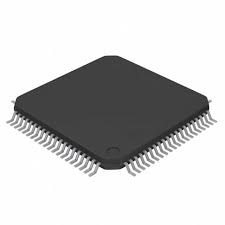 ADV7188BSTZ Video Decoder: Pinout,Specification,Datasheet
ADV7188BSTZ Video Decoder: Pinout,Specification,Datasheet15 May 2021392
 Unveiling the PIC16CE62X OTP 8-bit CMOS MCU with EEPROM Data Memory: Technical Deep Dive
Unveiling the PIC16CE62X OTP 8-bit CMOS MCU with EEPROM Data Memory: Technical Deep Dive29 February 2024308
 IRFP240 Power MOSFET: Pinout, Datasheet and Equivalent
IRFP240 Power MOSFET: Pinout, Datasheet and Equivalent29 October 20216268
 MJE350 Transistor: Complementary, Datasheet, and Pinout
MJE350 Transistor: Complementary, Datasheet, and Pinout22 October 20212552
 Yageo RC0603FR-0710KL Price Trends Across Suppliers 2025
Yageo RC0603FR-0710KL Price Trends Across Suppliers 202520 August 2025679
 S9012 Transistor: BJT Transistor, Datasheet, Equivalent
S9012 Transistor: BJT Transistor, Datasheet, Equivalent17 January 20227955
 cr2016 vs cr2025 Battery: Which one do you prefer?
cr2016 vs cr2025 Battery: Which one do you prefer?02 April 202277490
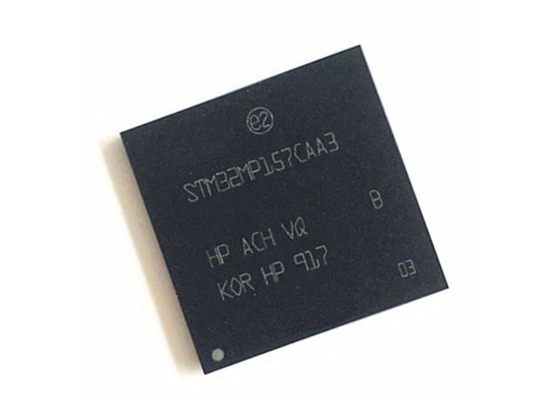 STM32MP157CAA3 Development: From Setup and Configuration to Advanced Features Implementation
STM32MP157CAA3 Development: From Setup and Configuration to Advanced Features Implementation07 June 2025453
 What is an Electromagnetic Relay?
What is an Electromagnetic Relay?13 October 20209474
 Memory Chip: The Key to Smart Connectivity
Memory Chip: The Key to Smart Connectivity03 November 20212314
![Comprehensive Guide to Car Chips [FAQs]](https://res.utmel.com/Images/Article/e686e156-9363-4bbc-b1fd-c44fbe3ecbda.jpg) Comprehensive Guide to Car Chips [FAQs]
Comprehensive Guide to Car Chips [FAQs]11 January 20225186
 Detailed Explanation of MOSFET
Detailed Explanation of MOSFET12 March 202215307
 Does the Terminal Resistance of the CAN Bus Have to be 120Ω?
Does the Terminal Resistance of the CAN Bus Have to be 120Ω?19 April 202232997
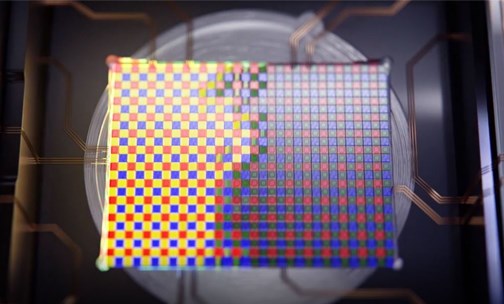 Huawei's Sensor Layout
Huawei's Sensor Layout24 March 20221776
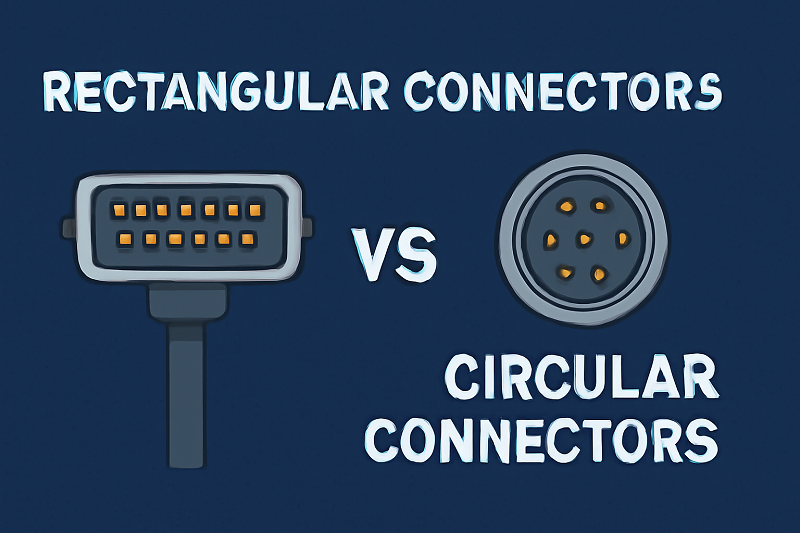 Rectangular Connectors vs Circular Connectors: Which fits your Project Best
Rectangular Connectors vs Circular Connectors: Which fits your Project Best04 July 2025607
 Switching Diodes Basics: Working, Types and Circuit Analysis
Switching Diodes Basics: Working, Types and Circuit Analysis24 October 202539961
FDK America, Inc., a member of Fujitsu Group
In Stock
United States
China
Canada
Japan
Russia
Germany
United Kingdom
Singapore
Italy
Hong Kong(China)
Taiwan(China)
France
Korea
Mexico
Netherlands
Malaysia
Austria
Spain
Switzerland
Poland
Thailand
Vietnam
India
United Arab Emirates
Afghanistan
Åland Islands
Albania
Algeria
American Samoa
Andorra
Angola
Anguilla
Antigua & Barbuda
Argentina
Armenia
Aruba
Australia
Azerbaijan
Bahamas
Bahrain
Bangladesh
Barbados
Belarus
Belgium
Belize
Benin
Bermuda
Bhutan
Bolivia
Bonaire, Sint Eustatius and Saba
Bosnia & Herzegovina
Botswana
Brazil
British Indian Ocean Territory
British Virgin Islands
Brunei
Bulgaria
Burkina Faso
Burundi
Cabo Verde
Cambodia
Cameroon
Cayman Islands
Central African Republic
Chad
Chile
Christmas Island
Cocos (Keeling) Islands
Colombia
Comoros
Congo
Congo (DRC)
Cook Islands
Costa Rica
Côte d’Ivoire
Croatia
Cuba
Curaçao
Cyprus
Czechia
Denmark
Djibouti
Dominica
Dominican Republic
Ecuador
Egypt
El Salvador
Equatorial Guinea
Eritrea
Estonia
Eswatini
Ethiopia
Falkland Islands
Faroe Islands
Fiji
Finland
French Guiana
French Polynesia
Gabon
Gambia
Georgia
Ghana
Gibraltar
Greece
Greenland
Grenada
Guadeloupe
Guam
Guatemala
Guernsey
Guinea
Guinea-Bissau
Guyana
Haiti
Honduras
Hungary
Iceland
Indonesia
Iran
Iraq
Ireland
Isle of Man
Israel
Jamaica
Jersey
Jordan
Kazakhstan
Kenya
Kiribati
Kosovo
Kuwait
Kyrgyzstan
Laos
Latvia
Lebanon
Lesotho
Liberia
Libya
Liechtenstein
Lithuania
Luxembourg
Macao(China)
Madagascar
Malawi
Maldives
Mali
Malta
Marshall Islands
Martinique
Mauritania
Mauritius
Mayotte
Micronesia
Moldova
Monaco
Mongolia
Montenegro
Montserrat
Morocco
Mozambique
Myanmar
Namibia
Nauru
Nepal
New Caledonia
New Zealand
Nicaragua
Niger
Nigeria
Niue
Norfolk Island
North Korea
North Macedonia
Northern Mariana Islands
Norway
Oman
Pakistan
Palau
Palestinian Authority
Panama
Papua New Guinea
Paraguay
Peru
Philippines
Pitcairn Islands
Portugal
Puerto Rico
Qatar
Réunion
Romania
Rwanda
Samoa
San Marino
São Tomé & Príncipe
Saudi Arabia
Senegal
Serbia
Seychelles
Sierra Leone
Sint Maarten
Slovakia
Slovenia
Solomon Islands
Somalia
South Africa
South Sudan
Sri Lanka
St Helena, Ascension, Tristan da Cunha
St. Barthélemy
St. Kitts & Nevis
St. Lucia
St. Martin
St. Pierre & Miquelon
St. Vincent & Grenadines
Sudan
Suriname
Svalbard & Jan Mayen
Sweden
Syria
Tajikistan
Tanzania
Timor-Leste
Togo
Tokelau
Tonga
Trinidad & Tobago
Tunisia
Turkey
Turkmenistan
Turks & Caicos Islands
Tuvalu
U.S. Outlying Islands
U.S. Virgin Islands
Uganda
Ukraine
Uruguay
Uzbekistan
Vanuatu
Vatican City
Venezuela
Wallis & Futuna
Yemen
Zambia
Zimbabwe




















